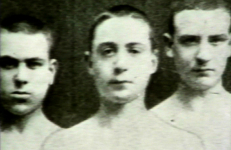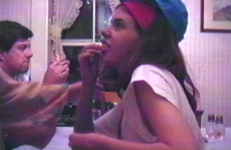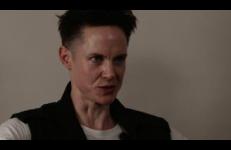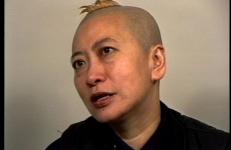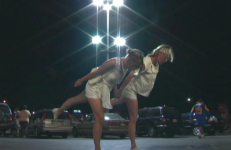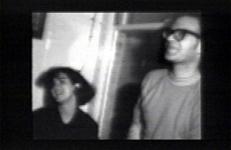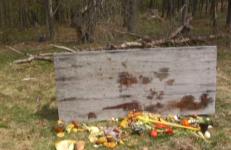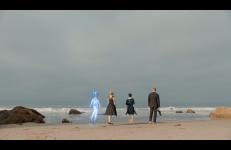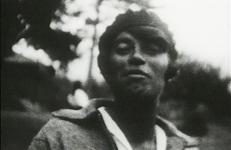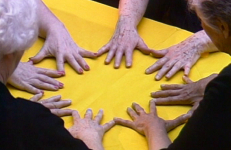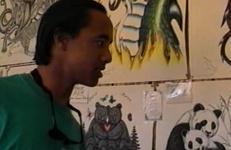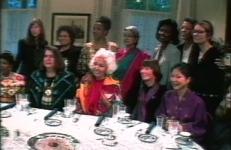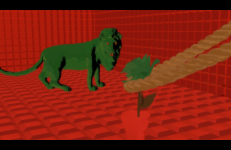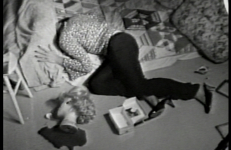Produced for Britain’s Channel 4, Bright Eyes is an impressive and complex essay detailing the various factors that have colluded to misrepresent the true nature of the threat posed by AIDS. Exposing the relationship between the mass media, scientific systems of classification, and definitions of pathology, Marshall pinpoints the construction of sexual politics based on a reactionary morality. The video places the AIDS crisis in the context of the historical persecution of homosexuals and focuses on the efforts of gay activist groups to combat social and medical prejudice.
Gender
A family embraces the heart of evil in this Poltergeist re-make/drag show, circa 1992.
In conversation with David Getsy — an art historian focusing on queer and transgender methodologies in sculpture theory and performance history — Cassils discusses their monumental performance artworks and inspirations.
As regional character disappears and corporate culture homogenizes our surroundings, it's increasingly hard to tell where you are. In Chain, malls, theme parks, hotels and corporate centers worldwide are joined into one monolithic contemporary "superlandscape" that shapes the lives of two women caught within it. One is a corporate businesswoman set adrift by her corporation while she researches the international theme park industry. The other is a young drifter, living and working illegally on the fringes of a shopping mall.
Taiwanese artist Shu Lea Cheang (b. 1954) tackles conceptions of racial assimilation in American culture, examining the political underbelly of everyday situations that affect the relationship between individuals and society.
C.L.U.E. (color location ultimate experience), Part 1 is a collaborative video and performance work by artists A.L. Steiner and robbinschilds, with AJ Blandford and Seattle-based band Kinski. Inhabiting the intersection of human movement and architecture, A.L. Steiner and robbinschilds (Sonya Robbins and Layla Childs) present a full-spectrum video, set to a score by rock quartet Kinski.
C.L.U.E. (color location ultimate experience), Part 1 is a collaborative video and performance work by artists A.L. Steiner and robbinschilds, with AJ Blandford and Seattle-based band Kinski. Inhabiting the intersection of human movement and architecture, A.L. Steiner and robbinschilds (Sonya Robbins and Layla Childs) present a full-spectrum video, set to a score by rock quartet Kinski.
Shot primarily in Fisher-Price pixelvision, for the “murky look of memory," Coal Miner’s Granddaughter is a profoundly moving family portrait focusing on the youngest daughter Jane, as she leaves her Pennsylvania home and finds sexual independence in San Francisco. This semi-autobiographical narrative is remarkable for Dougherty’s unconventional approach: working with non-professional, plain-looking actors and improvised dialogue to recreate the life of the “average” family, and women who are “Plain Janes with big desires.”
Community Action Center is a 69-minute sociosexual video by A.K. Burns and A.L. Steiner which incorporates the erotics of a community where the personal is not only political, but sexual. This project was heavily inspired by porn-romance-liberation films, such as works by Fred Halsted, Jack Smith, James Bidgood, Joe Gage and Wakefield Poole, which served as distinct portraits of the urban inhabitants, landscapes and the body politic of a particular time and place.
Community Action Center is a 69-minute sociosexual video by A.K. Burns and A.L. Steiner which incorporates the erotics of a community where the personal is not only political, but sexual. This project was heavily inspired by porn-romance-liberation films, such as works by Fred Halsted, Jack Smith, James Bidgood, Joe Gage and Wakefield Poole, which served as distinct portraits of the urban inhabitants, landscapes and the body politic of a particular time and place.
"Conspiracy Of Lies speaks of the alienation of minorities, of consumer culture, urban isolation and the fine balance between mental order and chaos. The video begins with a voice (my own) recounting the story of the discovery of a series of diary entries and lists written by an anonymous author. When I found the texts, I assumed the author to be a white, gay man, like myself. Through the use of twelve narrators of different race, gender, religion, and sexual orientation, I attempted to destabilize my own subjectivity and challenge my pre-existing assumptions regarding difference.
Contra-Internet: Jubilee 2033 is a re-imagining of scenes from filmmaker Derek Jarman’s 1978 queer punk film Jubilee, starring Susanne Sachsse and Cassils. Contra-Internet: Jubilee 2033 follows author Ayn Rand (Susanne Sachsse) and members of her Collective, including economist Alan Greenspan, on an acid trip in 1955. Guided by an artificial intelligence named Azuma, they are transported to a dystopian future Silicon Valley.
Stephen Varble (1946-1984) staged gender-confounding costume performances on the streets of 1970s Manhattan, and he became infamous for his anti-commercial disruptions of galleries, banks, and boutiques. In 1978, he retreated from this public work to focus on the making of an epic, unfinished piece of video art, Journey to the Sun, until his death in the first days of 1984. Lush, ribald, and unorthodox, the video mixed non-narrative costume performances with a surrealist fable of a messianic martyr, the Warbler.
Covert Action is a stunning melange of rapid-fire retro imagery accomplishing Child’s proclaimed goal to “disarm my movies.” “I wanted to examine the erotic behind the social, and remake those gestures into a dance that would confront their conditioning and, as well, relay the multiple fictions the footage suggests (the ‘facts’ forever obscured in the fragments left us). The result is a narrative developed by its periphery, a story like rumor: impossible to trace, disturbing, explosive.”
Coyolxauhqui recasts the mythical dismemberment of the Aztec Moon goddess Coyolxauhqui by her brother Huitzilopochtli, the deity of war, the Sun and human sacrifice. The film is a poem of perception, one that unveils how contemporary Mexican femicide is linked to a patriarchal history with roots in deeper cultural constructs.
“The idea was to address the cultural invisibility of older women through art and through action,” the voice-over explains as this video begins. This short works offers an introduction to the Whisper Minnesota Project, which organized The Crystal Quilt performance, an event that brought together hundreds of women over 60 on a Mother’s Day in Minneapolis. As the video explains, “The Crystal Quilt is a case study in reframing notions of older women’s beauty, power, and relevance. Through it we catch glimpses of life patterns and values lost to our generation.”
In this interview, American artist, independent curator, writer, and experimental filmmaker, Vaginal Davis reflects on her initiation into the punk rock and art scenes of Los Angeles during the 1980s and 90s, her stylistic influences, and her ongoing efforts to theorize queerness and visuality. Caught between the opposing poles of Hollywood classicism and the rawness of punk, Davis defines her unapologetically gender-bending, campy, and at times aggressively critical performances as scenarios, rather than spectacles or entertainment.
This title is only available on Kip Fulbeck Selected Videos: Volume One.
An insert square of a man running is superimposed over a magnified mouth that speaks to him — first in nurturing encouragement, then with a no-win Mommie Dearest kind of criticism. Originally presented as an installation on six monitors, Deadline focuses on “the stress man feels in the urban environment,” using a range of digital video effects to stretch, compress, flip and fracture the image.
Like a generation of viewers, I was profoundly affected by Deliverance. But I have always been troubled by the hegemonic structures of gender proposed by Boorman and Dickey. Hence, my version is played by women: myself, Peggy Ahwesh, Jackie Goss, Su Friedrich, and Meredith Root, all experimental filmmakers who work as academics. While faithful to our respective male characters, we also play ourselves.
Executive produced by Sara Diamond at the Banff Art Centre, co-produced by Michelle Baughn and Suzanne Lacy, directed by Tom Weinberg and Dick Carter, and edited by Holen Kahn.
Distracted Blueberry follows a performance art band through a series of poetic encounters. Masculine tropes are undone to form a relationship between male sexuality and the human death drive. The body, violence and humour are positioned in the larger context of nothingness and somethingness, bridging a tension between externalized anxieties and the terrors of nature. Evocative of inner emotional states, strange landscapes exist as reflections of our shared dreams and nightmares.
Viewer discretion advised
Blumenthal constructs a loose narrative around the sexual evolution of a woman (played by Yvonne Rainer) through a stunning collage of images appropriated from TV and film. Certain images come to dominate this effusive stream—tall buildings, sex scenes, an Elvis movie, the courtroom, fireworks. Doublecross pits the indeterminate, disruptive power of the erotic against the rigid, normalizing structures of family, law, marriage, popular culture, movies, and music—societal institutions that codify sexual relations.
In this video, Brenda Sexual, Glennda Orgasm, and friends act out a drag queen murder mystery that takes place on their talk show. Later, they attend the Queer Fashion Army Invasion, a sit in of openly queer public fashion performance outside the Fashion Institute of Technology in Manhattan. Then, the pair arrives at a video store to discuss queer undertones of Hollywood films, like Grease, Rocky II, and Yentil.
In this episode of The Brenda and Glennda Show, Brenda and Glennda create a satire of 1990's infomercials. The video includes interviews and performances by Vaginal Davis, Bruce LaBruce, and Chris Teen.
An episode of The Brenda and Glennda Show, hosted by Brenda Sexual and Glennda Orgasm.




